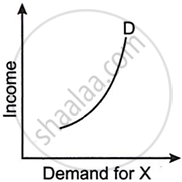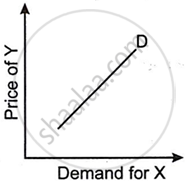Advertisements
Advertisements
Question
Explain the law of demand with its assumptions.
Solution 1
Assumptions of The Law of Demand:-
The Law of Demand is based on the following assumption.
1. Size and composition of the population remains constant:-
There should not be any change in the size and composition of the population. Because a change in population will bring about a change in demand even if the price remains the same.
2. The income of the consumer remains constant:-
The income of consumer should remain constant. If there is any change in income, demand tends to change even though the price is constant. For example, if income increases people will demand more quantity of a commodity even at a higher price.
3. Tastes and habits remain constant:-
Taste, habit, custom, tradition, and fashion, etc. should remain unchanged. Due to changes in taste and preference, people's demand for goods undergoes a change.
4. No change in expectations about future price changes:-
There should not be any change in the expectations about the prices of, goods in the future. If consumers expect that price will rise or fall in the future, they will change their present demand though price is.constant.
5. Prices of substitutes and, complementary goods remain constant:-
The prices of substitute and complementary goods should remain constant. For instance, if the price of tea rises, its demand will fall but demand for coffee will increase.
6. Government Policy remains constant:-
The taxation and fiscal policy of the government should not change. A change in income tax, for instance, may cause changes in consumer's disposable income and hence demand.
Solution 2
The law of demand is based on the following assumptions:
ii. The income of the consumer remains unchanged.
iii. Prices of related goods remain unchanged.
iv. Consumer’s tastes and preferences remain unchanged.
v. The government’s policies remain unchanged.
vi. There is no change in expectations about the future.
| Price of Commodity (X) (Rs) |
Quantity Demanded of X (Units) |
| 5 | 100 |
| 10 | 75 |
| 15 | 50 |
| 20 | 25 |
The schedule shows that as the price of commodity X increases from Rs 10 to Rs 15, the quantity demanded X falls from 75 units to 50 units. Thus, there is a negative relationship between demand and price.

Let us plot the above schedule on a graph. On the x-axis, we represent the quantity demanded; and on the y-axis, we represent the price of the good. Joining the different combinations of price and quantity demanded, we get a curve DD. This curve is the demand curve showing the inverse relationship between the price and the quantity demanded.
APPEARS IN
RELATED QUESTIONS
State and explain the ‘law of demand’ with its exceptions.
When does ‘increase’ in demand take place?
Explain the effect of change in prices of the related goods on demand for the given good.
Market of a commodity is in equilibrium. Demand for the commodity "increases." Explain the chain of effects of this change till the market again reaches equilibrium. Use diagram.
Prices of other goods and demand for the given good.
Explain how do the following influence demand for a good:
i. Rise in income of the consumer.
ii. Fall in prices of the related goods
Distinguish between individuals demand and market demand.
Good Y is a substitute of good X. The price of Y falls. Explain the chain of effects of this change in the market of X.
If with the rise in the price of good Y, demand for good X rises, the two goods are: (Choose the correct alternative)
a. Substitutes
b. Complements
c. Not related
d. Jointly demanded
How does change in the price of a substitute good affect the demand of the given good? Explain with the help of an example.
What does a rightward shift of demand curve indicate?
Fill in the blank using proper alternative given in the bracket:
Market demand is a total demand of...............buyers.
Define or explain the following concept.
Market Demand .
State with reason, whether you Agree or Disagree with the following statement.
The demand curve slopes downward from left to right.
Write explanatory notes or answer the following.
Aggregate demand
Do you agree with the following statement? Give reason
There are no exceptions to the law of demand.
Do you agree with the following statement? Give reason
State and explain the law of demand.
State with reasons whether you ‘agree’ or ‘disagree’ with the following statement.
Demand curve slopes downward from left to right.
Statements related to decrease in demand
- It is a type of change in demand
- It takes place due to unfavourable changes in other factors like tastes, income etc.
- Price remains constant
- Demand curve shifts to the right hand side of the original demand curve
Assertion (A): Under exceptional cases, demand curve has a positive slope.
Reasoning (R): In exceptional cases, consumer buys more when the price of a commodity rises and buys less when the price of commodity falls.
The shape of supply curve is ______
The demand curve for foreign exchange is ______
Identify the correctly matched items from Column I to that of Column II:
| Column I | Column II |
| (1) Demand Curve of Perfect Competition | (a) V-shaped Curve |
| (2) Demand Curve of Monopoly | (b) U-shaped Curve |
| (3) Demand Curve of Monopolistic Competition | (c) Upward rising |
| (4) Demand Curve of Oligopoly | (d) In-determinant |
Assertion (A): The demand curve is downward sloping.
Reason (R): The income effect means with a fall in the price of a good, the consumer's real income or purchasing power rises and he demands more units of the good.
In case of perfect competition, AR curve is:
Explain why the demand curve slopes downwards.
- Assertion (A): The demand curve slopes downwards.
- Reasoning (R): A fall in the price of goods increases the real income of the consumer enabling him/her to buy more.
Study the following table and answer the questions:
| Price of Ice Cream (₹) | Quantity Supplied | Market Supply | ||
| Seller A | Seller B | Seller C | (A + B + C) | |
| 50 | 0 | 2 | 5 | 7 |
| 100 | 1 | `square` | 10 | 15 |
| 150 | `square` | 6 | 15 | 23 |
| 200 | 3 | 8 | 20 | `square` |
| 250 | 4 | 10 | `square` | 39 |
Questions:
- Complete the above table.
- State whether the following statements are True or False.
(a) Market supply has a direct relation to price.
(b) As the price rises from ₹50 to ₹250, market supply rises from 7 to 39. This indicates an increase in supply.
Study the following diagram and answer the questions:

Questions:
- In which direction does the demand curve slope?
- What is the reason for the fall in demand of rice from Q0 to Q1?
Figures (A), (B) and (C) given below represent different types of Demand curves.
 |
 |
 |
| (A) | (B) | (C) |
What kind of goods do each of these Demand curves represent? Give a reason for each of the curves.
Draw a straight-line demand curve joining both the axes. Indicate the following on the demand curve.
Elasticity of demand is equal to zero
